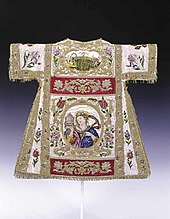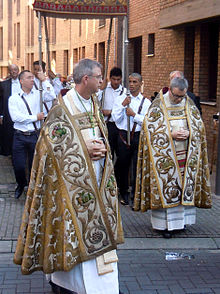Parament


Paraments ( neo-Latin word formation from parare , “prepare”, with the suffix -mentum ) are the textiles used in the church and in the liturgy , which are often artistically designed.
Types of paraments
Stoles , manipulas and the upper garments ( chasuble , dalmatic , tunicella , cope ) of the liturgists as well as chalice veil , desk veil and bursa are based on the respective liturgical color .
- The chalice veil is a cloth used to cover the chalice .
- The desk velum covers the portable desk on which the missal lies.
- The bursa is a hinged pocket with a stiffened insert for storing and receiving the corporal .
One of the parameters of the altar is the so-called Cup wash. It consists of palla, corporal, goblet velum and lava cloth, made of pure linen.
- The corporal is a square cloth. It is used as a base for the chalice and host bowl during the celebration of mass.
- The palla is a square, stiff covering of the chalice. Its practical importance is that it prevents contamination or evaporation of the altar wine.
- The chalice cloth ( purificatorium ) is used to clean the chalice and host bowl after communion .
- The lava towel is used to dry your hands after washing your hands.
- The altar cloth is the support of the altar . In old, baroque churches, altar cloths are often decorated with valuable, hand-made lace .
A distinction is made between ciborium velum and the velum as an item of clothing:
- The ciborium velum is a cloth to cover the vessel for storing the holy of holies .
- The velum as liturgical clothing is also known as the shoulder velum . According to ancient custom, it is wrapped around the liturgical utensils so that they are not touched with bare hands.
Furthermore, in addition to the aforementioned, cloths (such as the pallet ), velen to cover the cross in the Passion time , curtains, wall hangings and carpets belong to the parament of a church.
Manufacturing and history
Some monasteries make paraments and also carry out repair work. Parament workshops are often located in places of pilgrimage or at the bishopric of a diocese or archdiocese. In the House of Silk Culture , a former parament weaving mill in Krefeld (North Rhine-Westphalia), and in the mother house of the Franciscan Sisters of the Divine Heart of Jesus in Gengenbach (BW) there are art and parament museums. The world's oldest Protestant parament workshop goes back to Wilhelm Löhe and is located in a former prayer room of the deaconesses in Neuendettelsau. Löhe founded the first evangelical parament society in 1858 and published the basic text Vom Schmuck der Heilige Orte (The Decoration of Sacred Places) in 1857/58 . The font artist Rudolf Koch , who developed a canon for symbols and fonts, provided further important impulses .
See also
Individual evidence
- ↑ Art and Parament Museum Gengenbach ( Memento of the original from December 12, 2011 in the Internet Archive ) Info: The archive link has been inserted automatically and has not yet been checked. Please check the original and archive link according to the instructions and then remove this notice.
- ^ Paramentik der Diakonie Neuendettelsau
- ^ A b Author collective: Textile Art Church: Paraments and textile art in the church . Ed .: Evangelical Church in Hesse and Nassau. Edition 2000. Justus-von-Liebig-Vlg, Darmstadt 2012, ISBN 978-3-87390-319-7 , pp. 127 .
literature
- Sr. Klara Antons: Paraments - dimensions of the sign shape . Schnell and Steiner, Regensburg 1999, ISBN 3-7954-1214-5 .
- Franz Bock : History of the liturgical vestments of the Middle Ages, or the origin and development of ecclesiastical vestments and paraments with regard to fabric, fabric, color, drawing, cut and ritual meaning. Proven and explained by 120 illustrations in color print v. Franz Bock. 3 vol., Bonn 1859, 1867, 1871
- Joseph Braun : Handbuch der Paramentik. Herder, Freiburg im Breisgau 1912 ( full text ).
- Michael Braunsteiner and Heimo Kaindl (eds.): Historical textiles from the sacral area: meaning and use. Exploration and conservation . Admont, Diocesan Museum Graz 1998.
- Sr. M. Augustina Flüeler: Paraments. NZN-Verlag, Zurich 1949.
- Wolfgang Huber (Ed.): Paraments! historical liturgical textiles . Diocesan Museum St. Pölten, St. Pölten 2011.
- Heimo Kaindl (Ed.): Sunday speech and everyday life. A little cultural history of church clothing . Diocesan Museum Graz, Graz 2012.
- Hermann Schaffer : Two lectures on and about the Brotherhood of Eternal Adoration (Parament Association) held in Neisse by Hermann Schaffer, secular priest . Rosary and Bear, 1865.
- Nicodemus C. Schnabel: The liturgical vestments and insignia of the deacon, presbyter and bishop in the churches of the Byzantine rite. Echter, Würzburg 2008.
- Karen Stolleis: vestments made from German church treasures from the Middle Ages to the present: history, form and material . Schnell & Steiner, Regensburg 2001, ISBN 3-7954-1254-4 .
- Hiltrud Westermann-Angerhausen (Ed.): Museum Schnütgen - The liturgical vestments, 11th to 19th centuries . Cologne 2001, ISBN 3-932800-05-2 .

